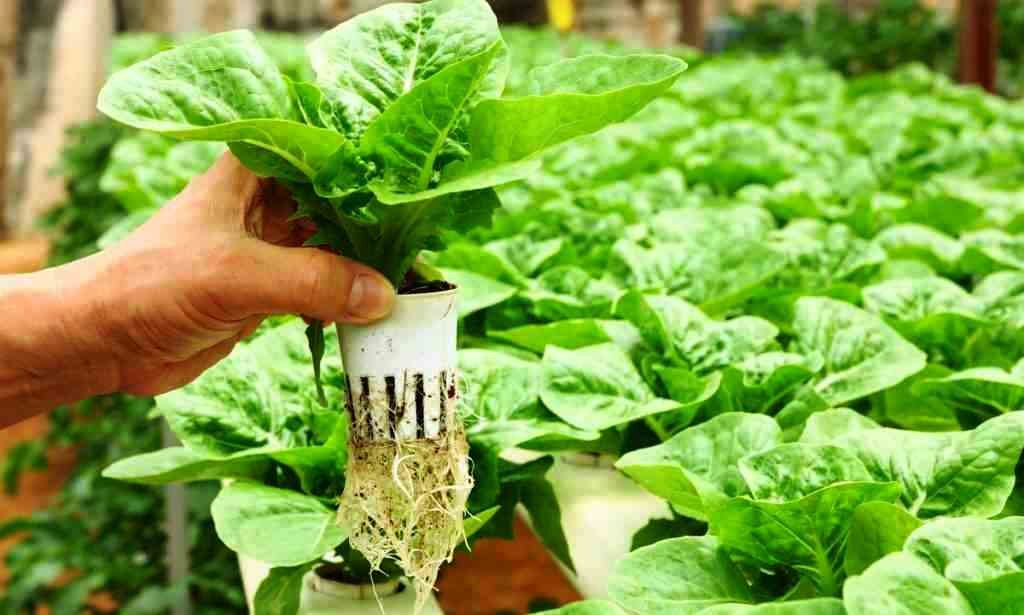Hydroponics is a soilless gardening technique that is gaining popularity for its efficient use of resources and ability to produce high-quality crops. In hydroponics, plants are grown in nutrient-rich water solutions instead of traditional soil. This method allows for precise control over nutrient levels, pH balance, and water usage, resulting in faster growth and higher yields. With hydroponics, gardening becomes possible in limited spaces, urban environments, and areas with poor soil quality. This innovative approach to cultivation offers sustainable and environmentally friendly solutions for food production.
What is Step by Step Guide to Grow Hydroponic vegetables Indoor
Growing hydroponic vegetables indoors offers a convenient and efficient way to cultivate fresh produce year-round. Follow this step-by-step guide to get started:
- Set up your hydroponic system: Choose a suitable system such as nutrient film technique (NFT), deep water culture (DWC), or ebb and flow. Install the necessary components, including a reservoir, pump, grow trays, and growing medium.
- Select the right vegetables: Opt for vegetables that thrive in hydroponic environments, such as lettuce, herbs, tomatoes, and peppers. Consider factors like space, lighting, and temperature requirements.
- Prepare the nutrient solution: Mix a balanced hydroponic nutrient solution according to the manufacturer’s instructions. Ensure proper pH levels for optimal nutrient uptake.
- Start seeds or obtain seedlings: Either germinate seeds in a nursery tray with a moist growing medium or purchase seedlings from a reputable source.
- Transplant seedlings: Once the seedlings have developed a strong root system, carefully transfer them to the hydroponic system, ensuring that the roots are properly submerged or supported by the growing medium.
- Provide optimal lighting: Install appropriate grow lights or position the hydroponic system near a sunny window. Ensure plants receive adequate light for photosynthesis.
- Monitor and adjust: Regularly check pH and nutrient levels in the reservoir. Adjust as needed to maintain optimal conditions for plant growth.
- Maintain the hydroponic system: Keep the system clean and free from debris. Regularly inspect for pests and diseases, and take necessary measures to control them.
- Harvest and enjoy: Harvest vegetables as they mature, following the recommended guidelines for each specific crop. Rinse thoroughly before consuming.
By following this step-by-step guide, you can successfully grow a variety of hydroponic vegetables indoors and enjoy the health benefits of fresh and nutritious produce year-round.
What are the Hydroponics Equipment Vegetable Growing
To successfully grow vegetables using hydroponics, you’ll need essential equipment to create an optimal growing environment:
- Hydroponic Systems: Choose from various types such as nutrient film technique (NFT), deep water culture (DWC), drip irrigation, or aeroponics. These systems provide a controlled environment for plant roots to absorb nutrients and water directly.
- Grow Lights: Since hydroponic setups are often indoors, you’ll need artificial lighting to supplement natural sunlight. LED grow lights are popular for their energy efficiency and customizable light spectrum.
- Nutrient Solutions: Hydroponic plants require a balanced mix of nutrients for healthy growth. Invest in a high-quality hydroponic nutrient solution that provides essential elements like nitrogen, phosphorus, and potassium.
- pH and EC Meters: Monitoring the pH level and electrical conductivity (EC) of your nutrient solution is crucial. pH meters measure acidity or alkalinity, while EC meters gauge the nutrient concentration in the water.
- Growing Medium: Hydroponic systems use different growing media, such as rockwool, coco coir, clay pellets, or perlite. These media provide support for the plants’ root systems and ensure proper water and nutrient retention.
- Pumps and Air Stones: In some systems, pumps circulate the nutrient solution, while air stones oxygenate the water. These components help deliver oxygen to the roots, promoting healthy growth.
- Timers and Controllers: Automation tools like timers and controllers allow you to schedule lighting, nutrient delivery, and system monitoring, ensuring consistency and precision in the growing process.
Investing in the right hydroponic equipment is essential for successful vegetable cultivation. Choose equipment that suits your specific needs and ensures optimal conditions for your plants’ growth and development.
What are the Simple steps for Grow Hydroponic vegetables
Growing hydroponic vegetables can be an exciting and rewarding experience. Here are some simple steps to get you started:
- Set up your hydroponic system: Choose a suitable system such as nutrient film technique (NFT), deep water culture (DWC), or drip irrigation. Install the necessary components, including a reservoir, pump, grow trays, and growing medium.
- Prepare the nutrient solution: Mix a balanced hydroponic nutrient solution according to the instructions provided. Ensure the solution has the right pH level for optimal nutrient absorption by the plants.
- Start with seedlings or seeds: Either purchase seedlings from a reputable source or start seeds in a nursery tray with a suitable growing medium. Ensure the seedlings have developed strong roots before transplanting.
- Transplant the seedlings: Gently transfer the seedlings into the hydroponic system, making sure the roots are properly submerged or supported by the growing medium. Allow space for each plant to grow and receive sufficient light.
- Provide adequate lighting: Install grow lights or position the hydroponic system near a sunny window to ensure the plants receive the necessary light for photosynthesis. Adjust the lighting duration based on the vegetable’s specific light requirements.
- Monitor and maintain: Regularly check the nutrient solution’s pH and adjust as needed. Keep an eye on the water level, ensuring it covers the roots without submerging them completely. Remove any dead leaves or debris to maintain a clean growing environment.
- Harvest and enjoy: As the plants grow, monitor their progress and harvest the vegetables when they reach maturity. Rinse the harvested produce thoroughly before consuming.
By following these simple steps, you can embark on a successful journey of growing hydroponic vegetables and enjoy the health benefits of fresh and nutritious homegrown produce.
Which Hydroponic vegetables You can Grow
When it comes to hydroponic gardening, there is a wide range of vegetables that you can grow successfully. Here are some popular choices:
- Leafy Greens: Lettuce, spinach, kale, and Swiss chard are excellent options for hydroponic cultivation. They grow quickly and are packed with nutrients, making them perfect for salads and healthy meals.
- Herbs: Basil, parsley, cilantro, and mint thrive in hydroponic systems. They require relatively less space and add fresh flavors to your dishes, making them a great addition to any indoor garden.
- Tomatoes: Hydroponics is well-suited for growing tomatoes, especially cherry and vine varieties. With proper support and regular pruning, you can enjoy a bountiful harvest of flavorful, vine-ripened tomatoes.
- Peppers: Bell peppers, chili peppers, and sweet peppers can be successfully grown hydroponically. These vibrant and versatile vegetables add a spicy or sweet kick to your culinary creations.
- Cucumbers: English cucumbers and smaller varieties like pickling cucumbers do well in hydroponic setups. With trellis support, they grow vertically and produce crunchy, refreshing cucumbers.
- Strawberries: Hydroponic systems offer an ideal environment for growing strawberries. The plants can be suspended in the air, allowing the fruits to hang freely and develop their sweet flavor.
Remember to choose vegetables that suit your space, lighting conditions, and preferences. Experiment with different varieties to find the ones that grow best in your hydroponic setup. Enjoy the satisfaction of harvesting your own fresh and delicious hydroponic vegetables right at home.
What does the hydroponic farming setup cost?
The total average cost of a one-time setup of hydroponics is between Rs 18,87,200 to 20,00,000. The cost of setting up a hydroponic farming system can vary depending on several factors. These include the size of the setup, the type of system chosen, and the equipment required. On average, a small-scale hydroponic setup can cost anywhere from a few hundred to a few thousand dollars. This includes expenses for hydroponic systems, grow lights, nutrient solutions, growing media, pH and EC meters, pumps, and other accessories. It’s important to consider the long-term health benefits and potential savings on water usage and pesticide usage that hydroponic farming offers. Careful planning and research can help optimize costs while ensuring a successful and sustainable hydroponic farming venture.
Future of Grow Hydroponic vegetables Indoor
The future of growing hydroponic vegetables indoors looks promising. With advancements in technology and a growing interest in sustainable agriculture, hydroponics is expected to play a significant role in the future of food production. Indoor hydroponic systems allow for year-round cultivation, independent of climate and seasonal limitations. This enables greater control over plant growth, leading to higher yields and reduced resource consumption. As more people become aware of the health benefits of hydroponics, it is likely to gain popularity and become a mainstream method of vegetable cultivation, ensuring a more reliable and sustainable food supply.




